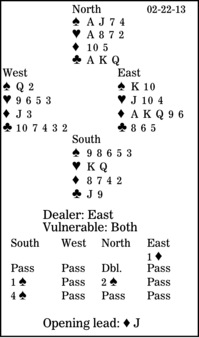Bridge column, February 22: The point-count points the way

In bridge, points -- those for high cards -- are very important. If it helps, count points on your fingers under the table, where no one else can see. Or use your fingers and toes!
Often, tracking high-card points will be invaluable for finding the right play. In this deal, how should East plan the defense against four spades after West leads the diamond jack?
South's advance of one spade showed zero to 8 points. (With 9 to 11, he would have jumped to two spades, and with 12 or more, he would have cue-bid two diamonds.) When North raised to two spades, he was saying that game was still possible. So he was promising 18 or 19 points. Now South, with six points and a fifth trump, was happy to jump to game.
East could see three tricks: the spade king and two diamonds. But the bidding suggested that South would have the heart king and at least one of the major-suit queens. If South had the spade queen, East had to hope his side would get a third-round heart trick. But if South had the heart queen, a second trump trick could be promoted.
East won the first trick with the diamond queen (in case West's jack was a singleton), cashed the diamond king, and carefully continued with the diamond six.
West saw what was required, ruffing with his spade queen. Now the contract had to fail.
** ** **
COPYRIGHT: 2013, UNITED FEATURE SYNDICATE
DISTRIBUTED BY UNIVERSAL UCLICK FOR UFS

